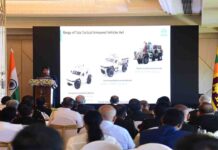By Wasana Nadeeshani
India (Commonwealth Union)_ A covert investigation is being conducted by apparel and technology businesses including Germany’s Siemens AG and Levi Strauss & Co. The pandemic gave rise to the concept of utilizing robots to bring back more production from abroad as clogged supply chains revealed the dangers of depending on far-off industries. Many manufacturers of clothing are reluctant to discuss the search for automation since doing so raises concerns that employees in underdeveloped nations would suffer. Jonathan Zornow, who invented a method to automate a few processes in denim manufacturing, acknowledged receiving online abuse and even a death threat. Aagaint this backdrop, a Levi’s representative has confirmed that the brand was involved in the project’s early stages but would not elaborate.
Contrary to plastic bottles or automobile bumpers, which maintain their shape when handled by a robot, fabric is floppy and available in a limitless variety of thicknesses and textures. Robots just lack the subtle touch that human hands are capable of. Although robots are developing, it will still be some time before they fully master the handling of cloth, according to five researchers contacted by Reuters.
Nevertheless, what if enough of it could be accomplished by a machine to at least partially reduce the cost gap between American companies and low-cost overseas industries? The current research endeavor has it as its main emphasis. Clothing is the final trillion-dollar sector that hasn’t been automated, according to Eugen Solowjow, project leader of a Siemens lab in San Francisco that has been working on automating textile production since 2018. Almost all denim is washed after it is created, thus this fits into the current production system, according to Zornow, the creator of Sewbo.
Work at Siemens began as an effort to develop software to direct robots that could handle various flexible materials, such as thin wire wires, according to Solowjow. He said that they soon recognized apparel was one of the most lucrative objectives. To assist traditional businesses with integrating the new technology, Siemens collaborated with the Pittsburgh-based Advanced Robotics for Manufacturing Institute, which was founded in 2017 and is supported by the Department of Defense. They located a San Francisco start-up that had a potential solution to the floppy fabric issue. Sewbo Inc., a company, stiffens the fabric with chemicals instead of teaching robots how to handle fabric so that it may be treated more like a car bumper during production.
Eventually, a number of clothing firms joined this research initiative, including Levi’s and Bluewater Defense LLC, a small military uniform manufacturer headquartered in the United States. The Pittsburgh Robotics Institute provided them with funding totaling $1.5 million so they could test the method.
Other initiatives to automate sewing factories exist. A Georgian business called Software Automation Inc has created a machine that, for example, can stitch T-shirts by pulling the fabric over a surface that includes particular equipment. Eric Spackey, CEO of uniform manufacturer Bluewater Defense, participated in the research project with Siemens, although he has reservations about the Sewbo method. According to Spackey, “putting (stiffening) material into the garment—it basically adds another procedure,” which raises costs. However, he adds that it could make sense for producers that already wash clothes as part of their routine operations, like jeans manufacturers.
Bringing robots into clothes manufacturers is the first step. After studying the Sewbo machines, Sanjeev Bahl, who founded the Saitex small jeans factory in downtown Los Angeles two years ago, is getting ready to set up his first trial machine. In September, as he led the way through his plant, he pointed out employees stooped over antiquated equipment and declared that many of these activities were suitable for the new method.
















